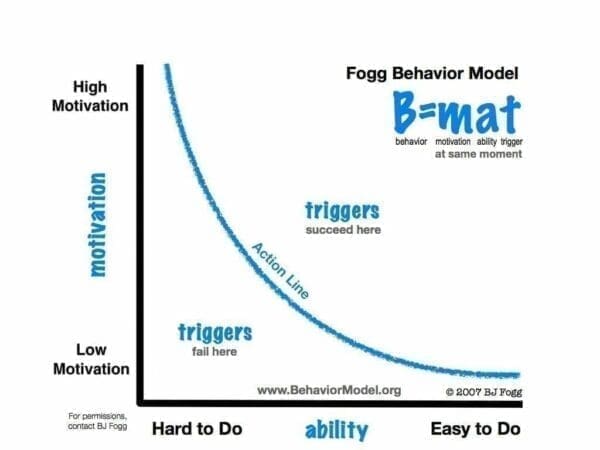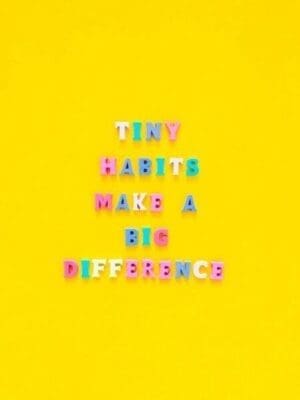Building Habits is Hard. Hard Because They Take Time and Effort. Time and Effort We Don’t Have But by Choosing the Right Trigger They Can Help You With How to Build a Habit.
Most people fail to create a habit. Go to the gym regularly? Drink more water? Read to the kids more? Habits we want to develop but we just don’t have the time. What if I told you time wasn’t the answer? It’s a term we use when something fails – ‘I didn’t have the time’. When actually, habit formation is a lot about repetition, and achieving repetition is about putting the right habit trigger into play.
Forming Habits
The rule of thumb is that it takes doing something 21 times to form a habit. As the Chinese proverb says, ‘Every journey starts with a single step’. Let’s start our habit journey by understanding the habit model and the triggers that accompany those.
BJ Fogg, a Stanford University Professor, is credited with being the father of habit formation through his work on habits. He concluded that every habit can be placed on a graph of two axes; motivation and ability.
In essence, how motivated you are to form the habit, and how able you are to do it. The graph looks like this:

The Three Habit Triggers (AKA Habit Prompts) to Help You with How to Build a Habit
The professor further concluded that based on where you would plot the activity/habit dictates the best trigger to use to give that activity the best chance of becoming a habit. Those 3 habit triggers are; Spark, Facilitator, and Signal.
Facilitator – Helping
This trigger fits at the top left of the graph. It is for those activities where we have high motivation but low ability. An example would be weight loss where you want to be thinner, but don’t know how to achieve it. This trigger is for when we need help to do the activity.
Sticky Learning ® is 7 times more effective than 1-day training courses. Plus, you will get a Chain of Evidence proving your Return on Investment. Discover soft skills training that changes behaviours long term.

Spark – Encouraging
The bottom right of the graph is where this trigger sits. For items where you have low motivation, yet high ability. Our example is if you knew what to do when you got to the gym, but just couldn’t be bothered. A Spark trigger is for when we need encouragement to do the activity to start the habit.
Signal – Nudging
When you have high motivation and high ability, this sits top right of the graph. Flossing your teeth is something you know how to do and you are pretty motivated to do it, but you need to be reminded. The Signal habit trigger helps us when we need nudging.
These three triggers will help you with how to build a habit because if you select the correct trigger based on the motivation and ability graph, forming habits becomes much easier.
Examples of Facilitator, Spark and Signal Habit Triggers
Facilitator Habit Trigger
Helping us with how to do something:
- Using an app at the gym for how to work out.
- A squaredance template on your office wall will help you to know how to prepare for a negotiation.
- Subscribing to our weekly self development tips will help you to be the very best version of yourself.
- Credit card-sized top tips will help you when you need to remember what are the 6 thinking hats.

Spark Habit Trigger
This trigger helps us with motivation:
- A picture of a slimmer you on the fridge.
- Placing your daily to-do list in or on your laptop when you switch it off in the evening will encourage you to write a to-do list each day, as you begin work.
- Having a copy of the book ‘How to Win Friends and Influence People’ will motivate you to be present when you are with other people, like in a meeting.
- A team charter posted in the meeting rooms will encourage us to adhere to the agreed meeting rules.
Signal Habit Trigger
A nudging trigger:
- Setting an alarm to remind you to go for a run at 6 am each day.
- Having a Pomodoro timer on your desk will remind you to use the timer to choose some activities to complete in 20 minutes.
- Adding ‘HBDI profile’ to each team meeting agenda will nudge the team to continuously improve how they communicate and work as a team.
- A model of a frog by your desk will nudge you to start each day by eating your frog.
Building Soft Skills Habits

Soft skills, or power skills, as they are becoming known, are some of the toughest to build habits for. This is because soft skills are less tangible. They are the things we do every day that are not hard & fast, but soft & slow. That said, you still can form habits for soft skills.
At one end of soft skills are the harder skills. They are negotiation and time management. Whilst at the other end are the softer of the soft skills, like influencing and presentation skills.
Using Habit Triggers to Create Soft Skills
Here are 9 examples of how you can start creating better habits for soft skills using the triggers we discussed above:
Time Management
- Carry a dictaphone in your car, and this will signal you to capture your thoughts about work, as you drive.
- Arrange your office so that blank paper and pens are at hand, so that you will be nudged to start each project, problem, idea, etc. not with Powerpoint but with pens and paper.
- Turn off your email notifications because you are using a signal trigger and this trigger is killing your productivity. The 4-minute badger will explain why.
Negotiating
- Have a list of the soft words on a post-it note in your wallet/purse, that give away your position.
- At the team meeting each week watch a negotiation exercise video to help you all to be the best version of yourself as negotiators.
- Each time an important client meeting is due, role-play the negotiation with your colleagues because it is better to sweat in training than bleed in battle.
Presenting
- Watch Amy Cuddy’s video on body language and have a picture of Wonder Woman on your office wall to remind of how you can be more influential.
- Print a stack of templates for how to start a presentation so that you do not start your presentation with PowerPoint.
- Each time you open Powerpoint use that as a trigger to review your keepers from the presentation skills training course and particularly to watch the video about not being nervous but being excited.
Placing Triggers to Make them Effective

When you make the choice to form a habit and use a trigger, it is often the place wher eyou put the trigger is the toughest. Here are a list of places you can put the trigger to help you with how to build a habit:
- A credit card/post it note in your wallet or purse.
- An A6 postcard stuck to your bathroom mirror.
- An image/drawing as your desktop background.
- A piece of text as your screensaver.
- Posters on your office wall.
- An inserted page in your notebook.
- A picture on the sun visor of your car.
- An image/text as your phone background.
- A piece of text as your phone screensaver.
- A post-it note attached to your computer.
- A model, like a frog, wher eyou put your pens.
- An alarm on your phone that reminds you.
- A stack of templates near or on your desk.
Forming habits is hard and the easiest way is to piggyback on another habit. For example, some years back I broke my foot. Afterwards, each day, I had to do my foot exercises to strengthen my foot. I chose to piggyback brushing my teeth. Each time I brushed my teeth I exercised my foot. The trigger was brushing my teeth as a signal to exercise my foot. As you grab a pen, coffee, or something else each day at work, if the image/text/model or something else is there, it will remind you/trigger you to form the habit.




